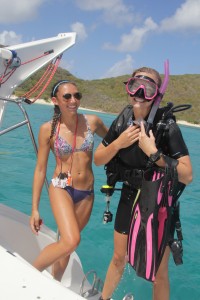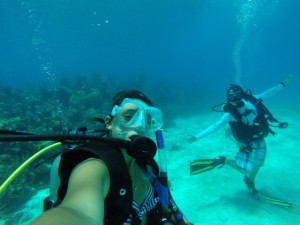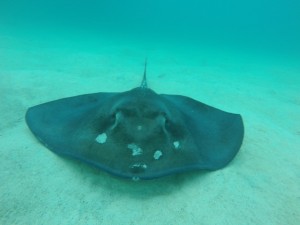This Island Times blog entry is part of a series of personal essays illustrating how SeaTrek has impacted the lives of our students and staff. We thank Hunter Blencowe, former student and 2015 intern, for this insightful look into the Underwater World of SeaTrek BVI.
Underwater With SeaTrek BVI
By: Hunter Blencowe

Hunter assisting on Deck Watch!
A fun, successful day under the water usually starts above water. We start our day by making fun of each other’s bed head and eating some delicious French toast while watching the sunrise off the stern of the boat. After breakfast we sail to our first dive site of the day! We are all very excited, especially those of us who have been to these dive sites on previous voyages. While on our way to the dive site we get our gear out and get it ready to put on and hop in the water. But before we get our gear out we choose a buddy from our fellow shipmates. (SeaTrek enforces the buddy system while diving always!) We set up our gear and check to make sure everything works and that there is plenty of air in our tanks. Then we check our buddy’s gear, just as we check our own that way we know everything about their gear as well.
FINALLY we arrived at the dive site!! We usually pick up a mooring ball instead of dropping anchor at dive sites. That way we preserve the precious sea life. A SeaTrek employee who is NAUI certified is our dive leader for all of our dives and once at the dive site, he or she calls all the students to the bow of the boat so they can brief us about the dive. We create a dive plan with our buddy for that dive. Usually the dives in the BVIs are above 60 feet; and if that’s the case then usually we do our time for 30 feet to 35 minutes underwater. We gear up with our buddy. We then help each other get our gear with the tank out of the tank rack and then onto our backs. Before we can get in the water we do our final buddy check to make sure everything is A-OK, and then we get our mask defogged, put our fins on and giant stride into the  water! Finally, we’re in the water!! We wait for our buddy to get in and then we both swim to the bow of the boat where the mooring/anchor line is. When it’s time to descend we signal to our buddy with the thumbs down signal and let the air out of our buoyancy control device (BCD).
water! Finally, we’re in the water!! We wait for our buddy to get in and then we both swim to the bow of the boat where the mooring/anchor line is. When it’s time to descend we signal to our buddy with the thumbs down signal and let the air out of our buoyancy control device (BCD).
On our way down we see beautiful coral with outstanding fish. Since SeaTrek trains us to do the REEF™ Fish ID surveys we can name most all the fish we see on the reef, as well as coral species. We swim past some elkhorn coral that is starting to bleach and a parrotfish making some sand! My absolute favorites are the Christmas tree and fan worms found on coral heads! I love to move the water around them so that they retract into their hole. They emerge a few seconds later, but they are just so cute and shy. I also love swimming by fire coral, I love to see its vibrant orange color underwater and it stings if you accidently touch it; but my favorite juvenile fish made their habitat fire coral. The juvenile yellow-tailed damselfish lives near fire coral. They are these tiny little fish that are a vibrant, shiny marine blue color with a bright yellow tail; but what makes the juveniles my favorite is that they have light blue spots on their head until they reach maturity. They are super cute and playful with each other, but at the same time very shy. The smaller they are, the cuter they get! They make me want to be a terrible person and just catch them and take them home to put in my fish tank, but I don’t actually do that.
We swim some more, always being careful to know exactly where we are from the boat so getting back won’t be an issue. We see a sea turtle if we’re lucky. The turtles we see range from small to really big! While on a dive one time I just swam right next to one; it was a large turtle and just stayed there. It didn’t mind my presence in the water at all. But if you’re super lucky you’ll see a juvenile lemon, black tip, or nurse shark in the BVIs. The nature of the BVIs makes it a perfect nursing ground for shark pups. Sadly the dive sites SeaTrek goes to don’t have that many shark visits while we are there.
We near the end of our dive and circle back to the boat. At 15 feet we stop and float neutrally buoyant for 3 minutes this is called a safety stop. It allows excess nitrogen in your body to have time to release itself before you reach the surface and it becomes trapped. Then we signal to our buddy with the “thumbs up” and ascend.
Once back aboard the boat we help our buddies take their gear off, and we store our gear away in the hatches at the bow of the boat. We then m eet in the cockpit to debrief about the dive and talk about the things we saw. Our SeaTrek/NAUI dive leaders are always helping us to learn new things and critique/improve our dive skills. We log our dives in our log books and then usually it’s about lunch time. Yum food! We are all starving from the dive so food is AMAZING! Then we pull anchor or drop the mooring ball and sail away to our next dive site. I can’t wait!
eet in the cockpit to debrief about the dive and talk about the things we saw. Our SeaTrek/NAUI dive leaders are always helping us to learn new things and critique/improve our dive skills. We log our dives in our log books and then usually it’s about lunch time. Yum food! We are all starving from the dive so food is AMAZING! Then we pull anchor or drop the mooring ball and sail away to our next dive site. I can’t wait!





Great blog, Hunter! Love the underwater selfie and your enthusiasm for every single dive. 🙂